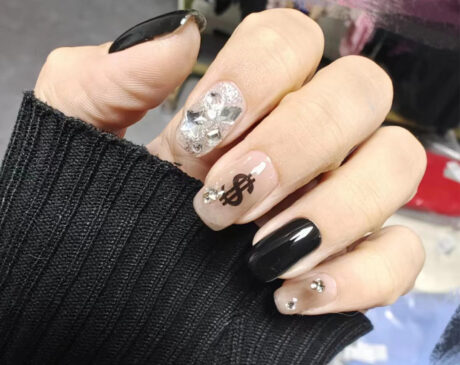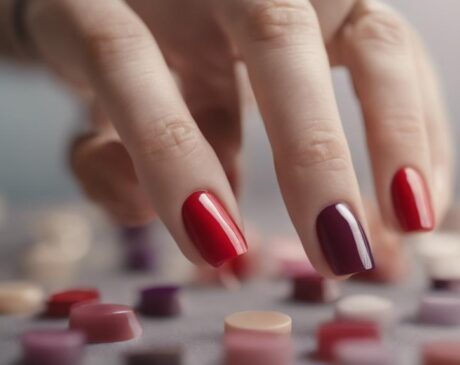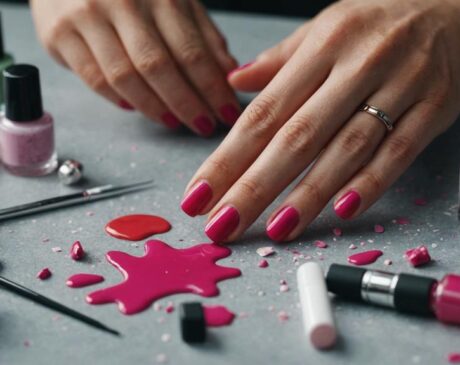Why Wont My Fake Nails Stick?
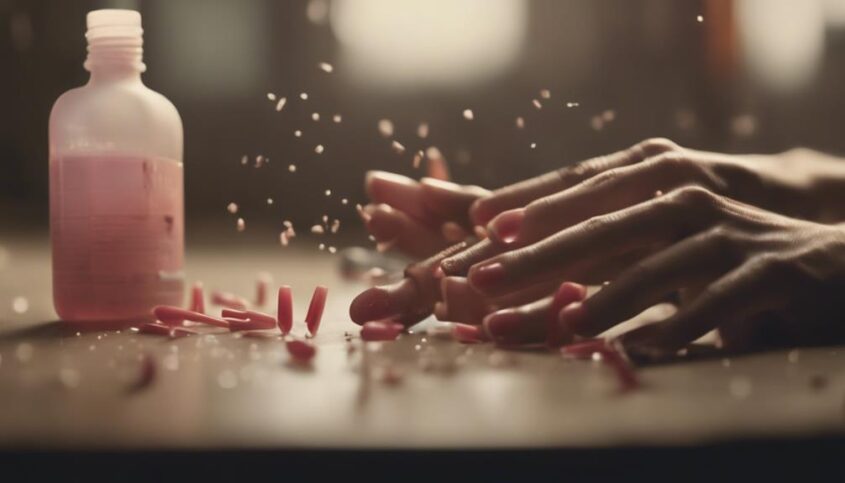
Improper nail preparation, incorrect sizing, low-quality adhesive, oily nail beds, or lacking a rough surface can cause fake nails not to stick. Ensuring proper nail cleaning and sizing, using high-quality adhesive, managing oily nail beds, and creating a rough surface will promote adhesion. Maintain nails by drying them well, sealing edges with a top coat, and protecting them from excessive water exposure. Quick application tips like pre-cut adhesive tabs and quick-dry nail glue can also aid in better adhesion. Understanding these factors will enhance the strength and longevity of your fake nails.
Key Takeaways
- Improper nail preparation like not filing nails smooth can hinder fake nail adherence.
- Incorrect nail size, whether too small or too large, leads to poor adhesion.
- Low-quality adhesive can cause fake nails to not stick properly.
- Oily nail beds prevent fake nails from adhering well.
- Lack of a rough surface on natural nails can hinder the bond with fake nails.
Improper Nail Preparation
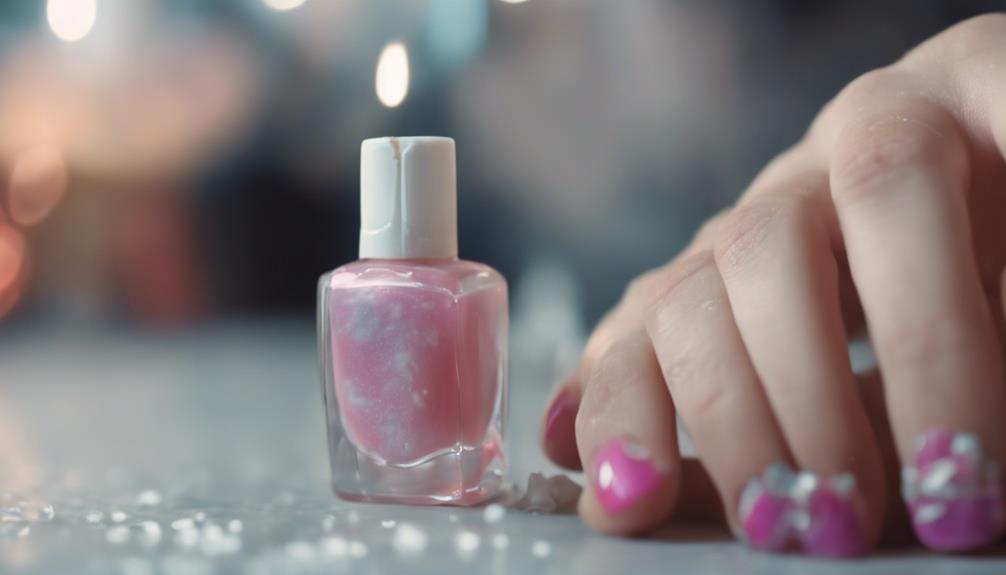
Improper nail preparation significantly hinders the adherence of fake nails, leading to potential lifting and detachment issues. Nail filing is a crucial step in creating a smooth surface for fake nails to bond effectively. By gently filing the natural nails, ridges and unevenness can be smoothed out, providing a better foundation for the fake nails to adhere to.
Proper cleaning of the nails is equally important in ensuring a strong bond. Residual oils, lotions, or debris on the nail surface can act as barriers, preventing the fake nails from sticking securely. Thoroughly cleansing the nails with a gentle nail polish remover or alcohol-based solution removes any impurities, promoting better adhesion.
Implementing these steps in nail preparation sets the stage for a successful application of fake nails, reducing the likelihood of premature lifting or detachment. By prioritizing nail filing and proper cleaning, individuals can enhance the longevity and durability of their fake nail enhancements.
Incorrect Nail Size
When fake nails don't stick, one common reason could be due to using incorrect nail sizes.
If the nails are too small, they won't adhere properly to the natural nail bed.
On the other hand, nails that are too big may not fit well, causing lifting and eventual detachment.
Nail Too Small
Inadequate sizing of fake nails often leads to difficulties in achieving proper adhesion to the natural nails. When the fake nail is too small for the natural nail, it creates gaps at the edges, causing air and moisture to seep in, ultimately loosening the bond.
This issue is especially common with unique nail shapes like stilettos or almond nails, where standard fake nail sizes may not align perfectly. Additionally, if the fake nail is too small, applying a gel overlay might not be sufficient to secure it in place, as the lack of contact between the fake and natural nail inhibits the gel from bonding effectively.
To prevent this, ensuring the correct size and shape of the fake nails is crucial for a durable and long-lasting manicure.
Nail Too Big
The challenge of fake nails adhering properly may also arise when the selected nail size is too large for the natural nail. When the fake nails are too big, it can lead to issues with adhesion and overall wearability.
To address this problem, consider the following innovative solutions:
- Nail filing: Gently file the sides of the fake nails to better fit the natural nail shape.
- Size verification: Double-check the size of the fake nails against your natural nails to ensure a proper fit.
- Customization: Explore customizable fake nail options that can be tailored to your nail size.
- Professional assistance: Seek help from a nail technician for expert advice on selecting the right nail size for optimal adhesion.
Low-Quality Adhesive
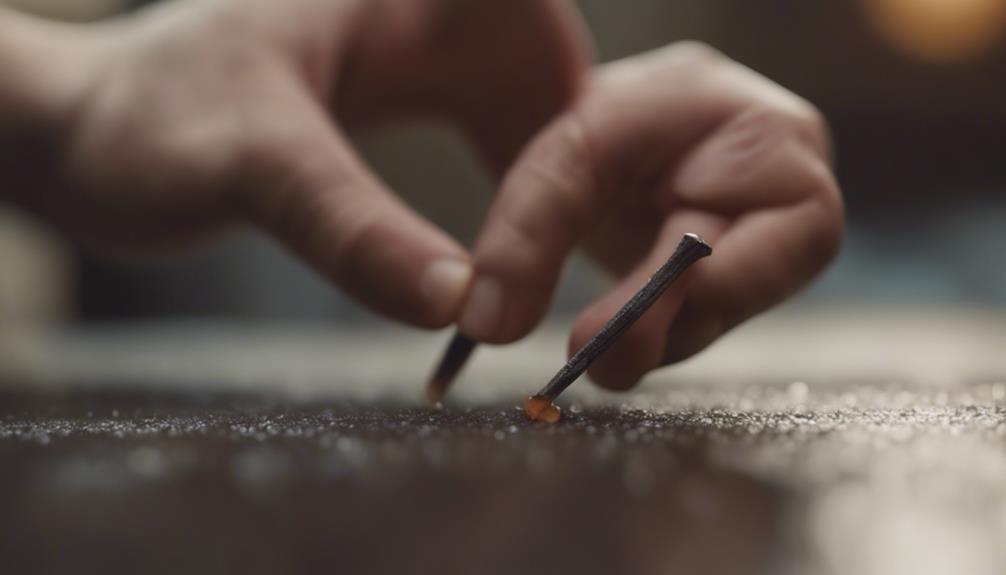
When it comes to fake nails, the quality of the adhesive used is crucial for a long-lasting hold.
It is essential to check the expiration date of the adhesive to ensure its effectiveness.
Applying the adhesive correctly and evenly is key to preventing any lifting or popping off of the fake nails.
Adhesive Quality Matters
Striving for a flawless adhesive application is crucial when it comes to ensuring the longevity of fake nails. When the quality of the adhesive is compromised, it can lead to various issues such as premature lifting or nail damage. Here are four key points to consider regarding the impact of low-quality adhesive:
- Adhesive Longevity: High-quality adhesives are formulated to last longer, providing a secure bond for an extended period.
- Nail Health: Inferior adhesives may contain harsh chemicals that can weaken natural nails over time, affecting their overall health.
- Application Technique: A superior adhesive requires precise application techniques to ensure optimal adhesion and a professional finish.
- Nail Care: Using a reputable adhesive contributes to the overall maintenance and care of your fake nails, promoting durability and a polished look.
Check Expiration Date
To ensure the effectiveness of the adhesive used for fake nails, a critical step is checking the expiration date, particularly when dealing with low-quality products. Using expired adhesive can lead to poor adhesion, resulting in fake nails not sticking properly. Proper storage of adhesive is also essential to maintain its quality and performance. Neglecting the expiration date of the adhesive can not only affect the longevity of the fake nails but also impact nail health by causing damage due to improper adhesion. Adequate hydration of the nails is crucial for their overall health and can be compromised if expired or poorly stored adhesive is used.
| Benefits of Checking Expiration Date | |
|---|---|
| Ensures proper adhesion | Prevents damage to nail health |
| Maintains longevity of fake nails | Promotes nail hydration |
| Avoids issues with fake nails | Enhances overall nail health |
Apply Correctly and Evenly
For optimal results when using low-quality adhesive for fake nails, it is crucial to apply the adhesive correctly and evenly. Ensuring a proper application can make a significant difference in the longevity of your fake nails. To achieve the best outcome, consider the following tips:
- Nail shape: Trim and shape your natural nails to match the fake nails for a seamless fit.
- Nail length: Adjust the length of your fake nails to match your natural nail length for a more natural look.
- Even distribution: Apply the adhesive evenly across the entire nail bed to prevent lifting or uneven adhesion.
- Press firmly: Press down firmly on the fake nail for a few seconds to allow the adhesive to bond effectively.
Oily Nail Beds
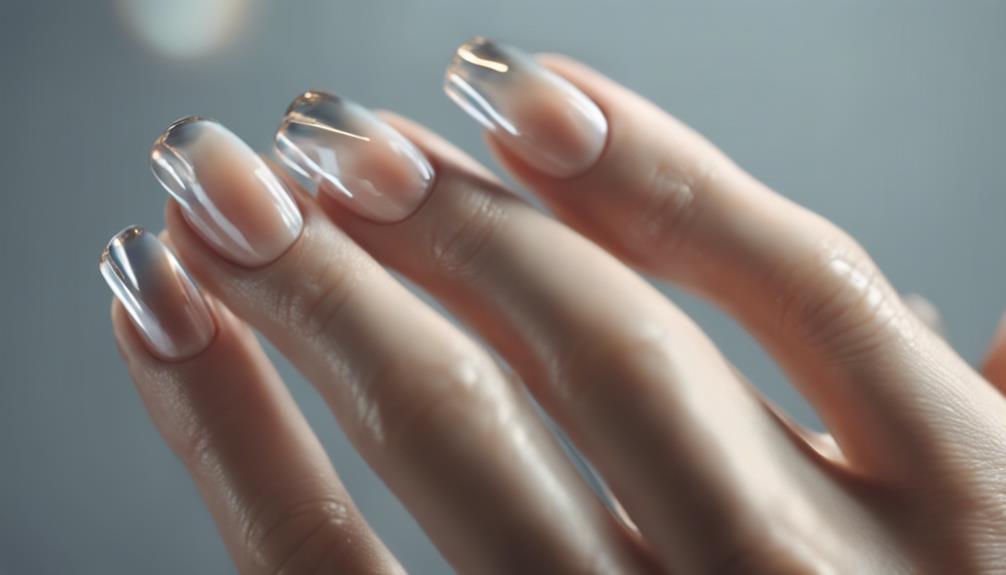
Excessive oil on the nail beds can often hinder the adherence of fake nails, causing them to lift or peel prematurely. Proper nail hygiene is crucial to address this issue.
Before applying fake nails, ensure that the nail beds are clean and dry. Regularly washing the hands with a gentle nail cleanser and thoroughly drying the nails can help reduce excess oil.
Additionally, using a nail primer prep can significantly improve the longevity of fake nails. Nail primers help to dehydrate the nail beds, creating a better surface for the fake nails to adhere to. They also aid in balancing the pH levels of the nails, which further promotes a secure bond.
Lack of Rough Surface
A smooth nail surface can hinder the proper adhesion of fake nails, leading to potential lifting or detachment issues. To enhance the bond between your natural nails and fake nails, it is essential to create a slightly rougher surface on your nails.
Here are some innovative ways to address the lack of rough surface:
- Nail Buffer: Use a nail buffer to gently roughen the surface of your natural nails, providing a better grip for the fake nails.
- Acid-Based Primer: Consider using an acid-based primer specifically designed to dehydrate the nail plate slightly, helping the fake nails adhere better to the surface.
- Textured Base Coat: Opt for a textured base coat that can create a rougher surface for the fake nails to grip onto securely.
- Nail Dehydrator: Prior to applying fake nails, use a nail dehydrator to remove any excess oils or moisture from the nail bed, promoting proper adhesion.
Exposure to Water
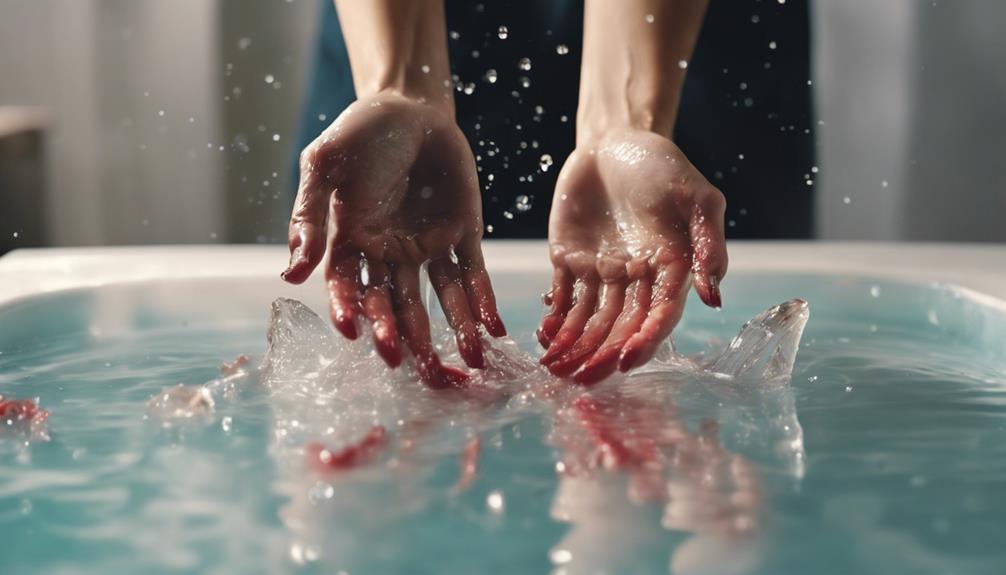
Prolonged exposure to water can significantly weaken the bond between fake nails and natural nails, leading to potential lifting and detachment issues. To combat this, it is crucial to implement proper drying techniques and nail care practices.
After being in contact with water, ensure thorough drying of both the fake and natural nails to prevent any moisture from getting trapped in between, which could compromise the adhesive. Utilizing a gentle nail buffer to remove any excess moisture and oils can also help enhance the longevity of your fake nails.
For optimal results, consider incorporating longevity tips into your nail care routine. Applying a top coat every few days can help seal the edges and reinforce the bond between the fake and natural nails. Additionally, being mindful of how often your hands are submerged in water and using gloves when doing chores can also aid in maintaining the integrity of your fake nails.
Quick Application Process
When aiming for efficient and effective fake nail application, prioritizing a streamlined process is key to achieving satisfactory results. To ensure a quick yet long-lasting outcome, consider the following innovative practices:
- Use Pre-Cut Nail Adhesive Tabs: Opt for pre-cut nail adhesive tabs to skip the trimming step, saving valuable time during the application process.
- Employ Quick-Dry Nail Glue: Quick-dry nail glue can significantly reduce the waiting time for the nails to set, allowing for faster application without compromising longevity.
- Invest in Press-On Nails: Press-on nails are a rapid alternative to traditional acrylics or gel nails, offering a swift application process with impressive durability.
- Utilize Nail Wraps: Nail wraps are efficient and easy to apply, providing a speedy solution for those seeking a quick nail enhancement without the need for curing or drying time.
Inadequate Nail Maintenance
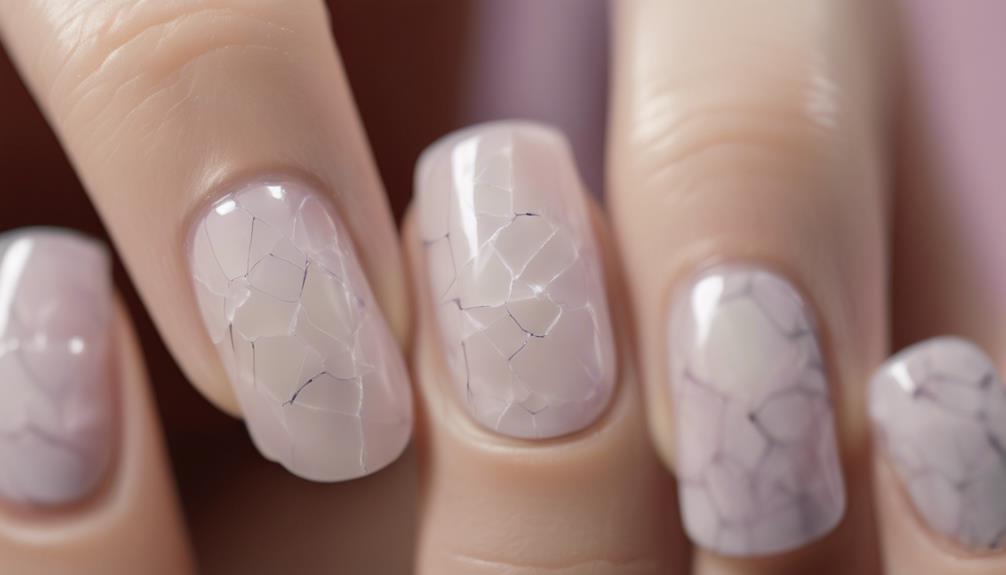
Insufficient attention to nail maintenance can undermine the longevity and adherence of fake nails, impacting the overall effectiveness of the application process. Nail hygiene and proper care are essential for ensuring that fake nails adhere well and last longer. Neglecting nail hygiene can lead to oil and debris buildup, creating a barrier that prevents fake nails from sticking properly. Additionally, not maintaining the natural nail properly can weaken its structure, making it harder for fake nails to adhere securely.
To maintain the health and strength of your nails, consider the following tips:
| Nail Hygiene | Proper Care | Nail Shape |
|---|---|---|
| Keep nails clean | Moisturize regularly | Choose a shape that complements your style |
| Avoid harsh chemicals | Trim and file nails | Consider trends but prioritize nail health |
| Use cuticle oil | Protect nails with gloves | Avoid overly sharp shapes for longevity |
| Regularly remove old polish | Avoid using nails as tools | Maintain a shape that suits your lifestyle |
Frequently Asked Questions
Can Fake Nails Be Reused After They Fall Off?
Fake nails can often be reused after they fall off with proper nail care and reapplication techniques. To maintain their appearance, consider incorporating new nail art designs or colors during the reapplication process for a fresh look.
How Long Should I Wait Before Applying Fake Nails After Removing Old Ones?
For optimal nail prep and application time, wait at least a few days before reapplying fake nails to allow natural nail recovery. Ensure thorough removal process to avoid damage. Allow ample glue drying time for a strong bond.
Are There Any Natural Remedies to Help Fake Nails Stick Better?
Research shows a growing trend towards seeking DIY nail glue alternatives and natural nail strengthening remedies. Innovation in natural ingredients like coconut oil, garlic, and green tea promotes nail health and may enhance the longevity of fake nails.
Can Wearing Gloves While Doing Household Chores Help Prevent Fake Nails From Falling Off?
Wearing gloves during household chores can significantly benefit nail care by preventing exposure to harsh chemicals and excessive moisture, aiding in the longevity of fake nails. This simple practice can help maintain the integrity of your manicure.
Is It Possible to Make Fake Nails Last Longer Without Using Harsh Chemicals or Products?
Enhancing nail care practices through innovative adhesive solutions can significantly extend the longevity of fake nails. By opting for gentle, yet effective products and techniques, individuals can enjoy prolonged wear without resorting to harsh chemicals.
Conclusion
In conclusion, failure of fake nails to adhere may be attributed to:
- Poor nail preparation
- Improper sizing
- Low-quality adhesive
- Oily nail beds
- Lack of rough surface
- Water exposure
- Hasty application
- Inadequate maintenance
Addressing these factors can help ensure a more successful outcome in achieving long-lasting fake nails.
Remember, like delicate petals needing proper care to bloom, fake nails require attention to detail for proper adherence.

